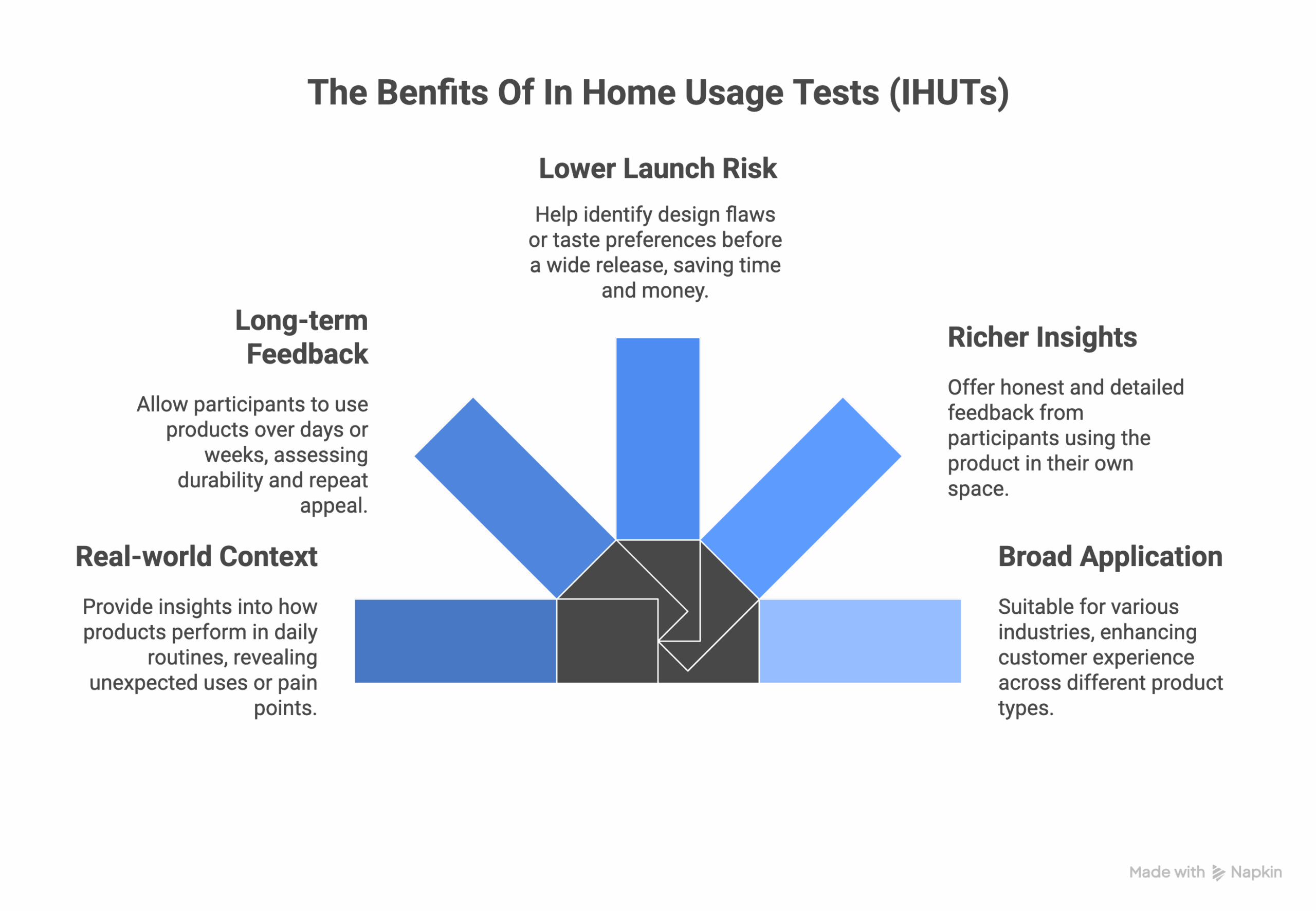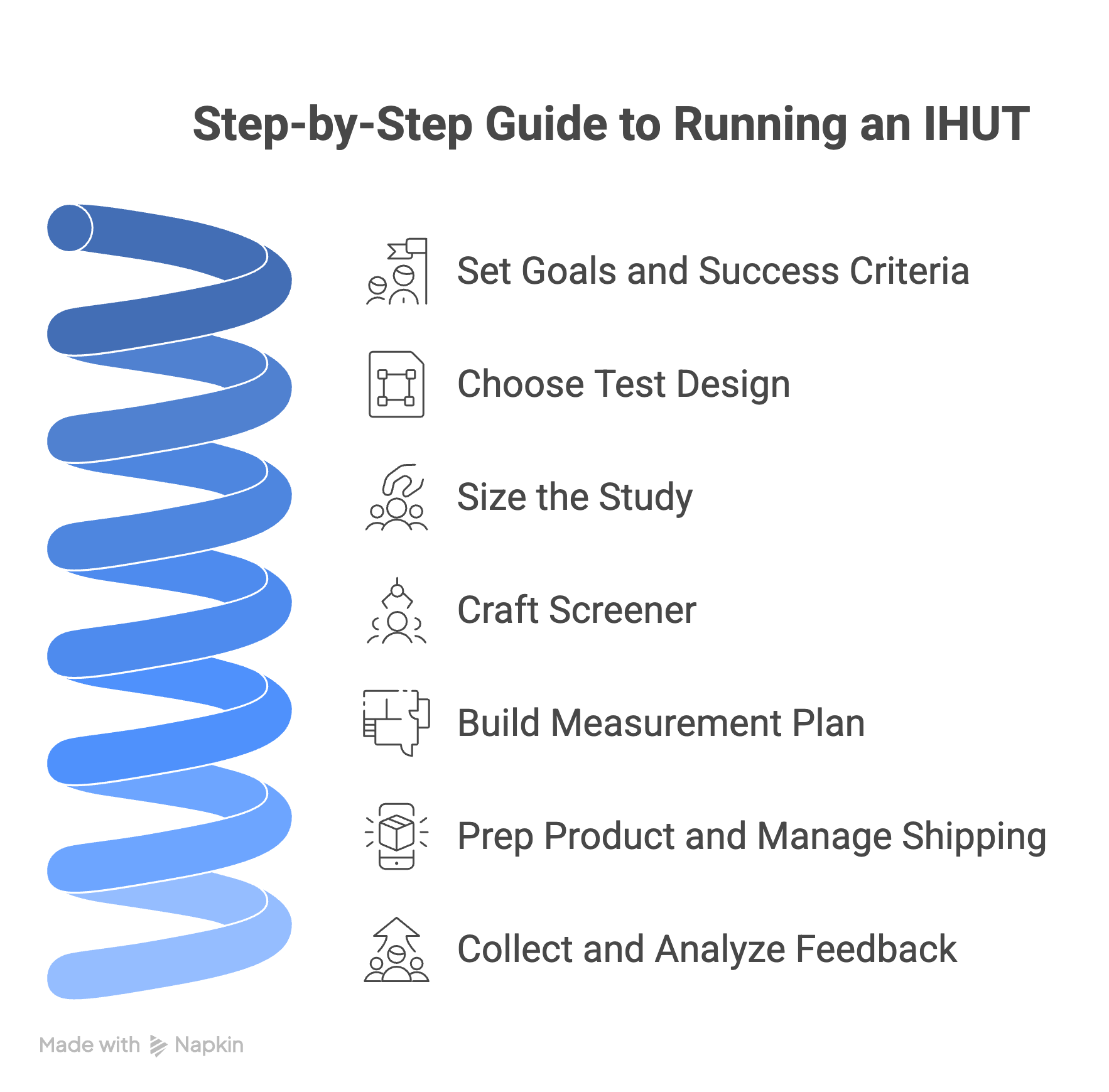In-Home Usage Tests, or IHUTs, are one of the most reliable ways to see how people actually use a product. By giving research participants a chance to try a product in their own homes and within the context of their normal routines, you get a very real understanding of how they engage with it.
This matters because how a product performs in real life can be very different from how it performs in a controlled setting. Packaging that looks fine in a conference room may be hard to open in a kitchen. A new snack might taste great during a quick sample but feel less appealing after a week of eating it.
IHUTs give you that real-world perspective before you commit to a full launch.
What Is An In Home Usage Test (IHUT)
An In-Home Usage Test, often shortened to IHUT, is a research method where you give real people a product to try at home and then ask for their feedback. Instead of testing in a lab or central location, the product goes into the environment where it’s meant to be used.
For example, if you’re launching a new coffee maker, you don’t just want people pushing buttons in a research facility. You want them brewing coffee in their own kitchen, noticing how it fits on the counter, whether the instructions are clear, and if the coffee actually tastes good day after day.
The same applies to food, household cleaners, beauty products, pet supplies, and just about anything people regularly use. By putting products in real-life settings, IHUTs show how they perform in ways that surveys, focus groups, or one-time demos can miss.
At the end of the test, participants usually complete a survey, diary, or interview to share their experiences. The result is feedback that feels more authentic and points to improvements you can make before a broader launch.
Why Perform an In Home Usage Test
Running an IHUT gives you insights you can’t get from other types of research. Here are the biggest reasons teams turn to this method:

- Real-world context: People use products differently at home than they do in a focus group facility. IHUTs let you see how a product performs when it’s part of daily routines, which often reveals pain points or unexpected uses you’d never catch in a controlled setting.
- Long-term feedback: Some products need more than a quick test to understand. With IHUTs, participants can use a product over days or weeks, giving you a sense of durability, repeat appeal, and whether satisfaction holds up over time.
- Lower launch risk: Catching issues early saves time and money. By spotting design flaws, packaging problems, or taste preferences before a wide release, you reduce the chance of expensive missteps in the market.
- Richer insights: Because participants are using the product in their own space, feedback tends to be more honest and detailed. They’ll describe what works, what doesn’t, and how the product fits—or doesn’t fit—into their everyday lives.
- Broad application: IHUTs aren’t limited to one type of product. From food and beverages to electronics and personal care items, the method works across industries where context and repeated use shape the customer experience.
Step-by-Step Guide to Running an IHUT
A successful IHUT includes the following steps:
1) Set goals and success criteria
Decide what decisions this IHUT will inform. List the 3 to 5 outcomes you care about most, like overall liking, repeat use, fit with routine, or packaging clarity. Define pass and fail thresholds so the team knows what “good” looks like.
2) Choose your test design
There are a few different ways to structure an IHUT. The design you pick depends on your goals, your budget, and how many products you want to test. Here are just a few of the typical designs we consider:
- Single product (monadic): Each participant tests just one product. This keeps feedback clean because people aren’t making direct comparisons. It’s the most common IHUT setup and works best when you want to know how a product performs on its own.
- Multiple products, one at a time (sequential monadic): Each participant tries more than one product, but at different times. For example, someone might use Brand A’s detergent for a week and then Brand B’s the following week. This setup allows for direct comparisons, but you’ll need to plan for “carryover effects” (the first product tested might influence how people rate the second).
- Side-by-side comparison: Participants use two or more products at the same time and compare them directly. This can work well for categories like snacks or beverages, where quick comparisons are easy, but it’s harder for products that require longer-term use, like skincare or appliances.
- Blind vs. branded: You’ll also need to decide if participants know what product or brand they’re testing. A blind test strips away brand influence and focuses purely on product performance. A branded test reflects how the product performs with packaging, claims, and the brand name in play.
- Control or benchmark: Sometimes it’s useful to include a known product as a baseline. This lets you see not just how your new item performs, but how it stacks up against what consumers are already using.

3) Size the study
Your sample size should match the type of decisions you want to make. Small IHUT sample sizes are great for exploration, while larger ones are better for statistically reliable reads.
- Exploratory learning (15–30 participants): If you’re in the early stages and just want to uncover issues or generate ideas, a small group is often enough. You’ll get rich qualitative feedback without the cost of scaling up.
- Directional insights (75–150 participants per product): When you want to see general patterns—like whether most people like one concept more than another—this mid-range sample gives you enough data to spot clear winners and losers, while keeping the study manageable.
- Statistical confidence (200–400 participants per product): If the goal is to make high-stakes decisions, like finalizing a launch product or choosing between packaging designs, you’ll want a larger sample. This reduces margin of error and ensures the results represent your broader audience with more confidence.
Keep in mind that the right size depends on how you’ll use the data. If you just need to find problems and fix them, small works. If you’re putting numbers in front of executives or retailers, go bigger so your results carry more weight.
4) Craft a screener to recruit the right audience
A screener is the questionnaire you use to make sure the right people end up in your study. Getting the right audience matters because feedback is only useful if it comes from people who actually represent your buyers. For example, if you’re testing a new plant-based yogurt, you’ll want participants who already eat yogurt and are open to dairy alternatives, not people who never shop in the category. A good screener covers basic demographics, category behavior, and any deal-breakers like allergies, past product tests, or brand conflicts. The more precise you are in defining your target up front, the more reliable and actionable your IHUT results will be.
And, this step also covers considering the incentives you’ll need to secure participation. It’s key to be thoughtful about participants’ time, and the “asks” during the study, so that they feel fairly compensated and committed to completing the necessary tasks.
5) Build the testing and measurement plan
The measurement plan is the backbone of your In Home Usage Test. It spells out what you’ll measure, when you’ll measure it, and how you’ll guide participants to use the product. Without this structure, people may test in ways that don’t give you the insights you need.
Here are the core pieces to include:
- Usage instructions: Decide up front how you want participants to use the product. Should they replace their current product entirely or use it alongside what they normally buy? Should they test daily, weekly, or whenever they’d naturally use it? Clear directions prevent inconsistent results, like one person trying a skincare product once while another uses it twice a day.
- Entry survey: Start with a baseline questionnaire before participants receive the product. Capture habits, expectations, and brand preferences. This provides the “before” picture that makes post-test results more meaningful.
- Unboxing check: Once the product arrives, ask participants to log the condition and ease of setup. Were instructions clear? Did anything feel confusing right out of the box? This step often highlights packaging or communication issues you’d never catch in a lab.
- In-use check-ins: Schedule 2–3 short surveys or diary entries during the test. These give you feedback while the product is fresh in people’s minds. Ask about ease of use, any problems, or standout positives. For richer insights, invite participants to upload photos or short videos of the product in action.
- Final survey: Wrap up with a more detailed survey that ties back to your goals. Cover overall satisfaction, likelihood to purchase, and value for money. Include open-ended questions so participants can describe their experience in their own words.
Tips for a solid plan:
- Make usage instructions as clear as the surveys. Ambiguity in either one leads to messy data.
- Keep each survey short and mobile-friendly to protect engagement.
- Use reminders to nudge participants at each step.
A strong measurement plan makes sure people test the product the way you intend and give feedback you can actually use.
6) Prep the product and manage shipping
Get each product ready for participants in a way that matches your testing plan. Include clear instructions and anything they need to use the product as intended. Pack the product so it arrives safely, and use tracking to make sure nothing gets lost. Timing matters too!. Try to get products to everyone close to the same start date. If you expect any replacements, have extras ready. The main goal is to make it easy for participants to test the product exactly as you planned and provide the feedback you need.
7) Collect and analyze feedback
Once participants have used the product, gather their feedback from surveys, diaries, photos, or videos. Make sure all responses are complete and check for any obvious errors, like missing answers or inconsistent ratings.
Start by looking at the data against your original success criteria. Compare ratings, comments, and trends across participants and, if applicable, different product versions. Look for patterns in what people liked, disliked, or found confusing. Don’t ignore open-ended responses. They often reveal insights you wouldn’t see in numbers alone.
After analyzing the results, turn them into clear, actionable recommendations. Highlight what should stay the same, what could be improved, and any major issues that need fixing before launch.
What Industries Benefit From In Home Usage Tests
In-home use tests aren’t limited to one type of product or industry. Any company that wants to see how people actually interact with a product in their own environment can benefit. Here are some common use cases:
- Food and Beverage: You can find out if people actually enjoy the taste, size, or freshness of your product over multiple uses. It’s also a great way to see how packaging works in real life.
- Household Cleaning Products: IHUTs show how well cleaning products fit into everyday routines. Participants can test them on different surfaces and tell you what really works and what doesn’t.
- Personal Care and Beauty: Skincare, haircare, and makeup products often behave differently over time. IHUTs reveal how things feel, smell, or absorb, and whether they play nicely with other products people already use.
- Pet Products: Pets don’t always behave in a lab. Testing food, toys, or grooming products in real homes helps you see what pets actually like and how owners interact with them.
- Electronics and Appliances: Watching people set up and use gadgets at home shows you what’s easy, what’s frustrating, and whether your product really makes life simpler.
- Apparel and Accessories: Fit, comfort, and durability can be hard to judge in a store. IHUTs let people wear items over time and give feedback on everyday use, care, and style.
No matter the category, IHUTs give teams a window into real-life product experiences, something you can’t get from lab tests or quick samples.
An IHUT Example
When one of our clients in the home cleaning space was preparing to launch a new product, they wanted to be sure it would hold up against strong competition in real households. Lab tests showed it performed well, but the team wanted authentic consumer feedback to confirm performance and gather insights for improvement.
Here is how we tackled this project.
Our Approach:
- Participant Recruitment: We screened and recruited participants who matched the client’s target audience. In this case, it meant women ages 50-70 who did the bulk of the cleaning in their households.
- Product Masking: All products were masked to remove brand influence. Participants focused solely on performance, not on brand loyalty or packaging.
- Testing Protocol: We developed a testing protocol to ensure that each product was used across at least 5 unique surfaces. Our goal was to collect feedback on the two products’ efficacy across different cleaning challenges. Additionally, to minimize bias, we randomized which product respondents tested first.
- Shipped Test Kits: Each participant received a kit with clear instructions, testing guidelines, and standardized measurement tools. This made sure everyone tested the product in the way the plan intended.
- Data Collection: Participants were given several days in which to test both products, and were given paper rubrics on which to collect their feedback. They were then sent a digital survey to upload their feedback to allow for data analysis.
The Results
- High Engagement: Over 90% of participants completed the study and provided usable feedback, demonstrating very high recall and engagement rates.
- Objective Comparisons: Feedback from participants demonstrated that they found both products performed at parity across key cleaning tasks, confirming launch readiness.
- Actionable Insights: Open-ended comments highlighted opportunities to tweak texture and scent, giving the product team guidance for final refinements.
When You Should Reconsider Using An IHUT
While IHUTs are great for understanding real-world use, they’re not the right tool for every situation. There are certain scenarios or learning objectives that frequently indicate more structured research approaches are warranted.
If you need highly standardized usage…you likely need a more controlled test design. Studies that depend on all participants following identical procedures, like timing, dosage, or application, are often at risk to the real-world variability that comes into play with IHUTs.
If you need to understand the “why” behind behavior…you likely need a qualitative approach. IHUTs show how people rate products, but not necessarily why. Further, they often fail to capture how people are engaging with the products which can explain frustrations or challenges. Leveraging research methods that allow for observation are best in this scenario.
In essence, IHUTs are unmatched for authentic, real-life insights. But, but when precision or deeper understanding is needed, controlled or qualitative methods are the better choice.






